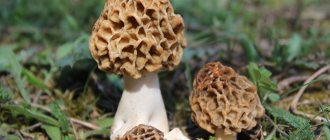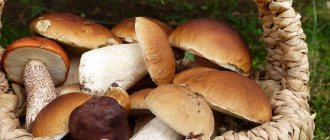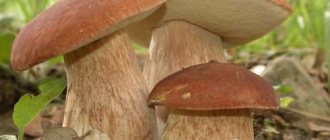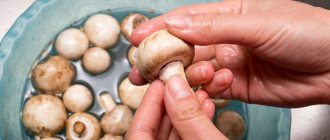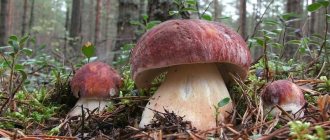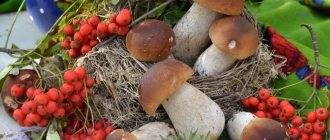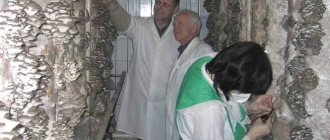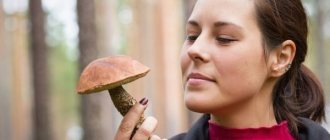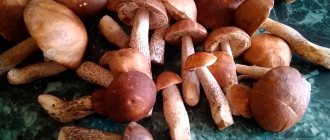Seasonal characteristics of mushroom growth
Fungi are complex organisms. Their main part - the mycelium or mycelium - is hidden from view by a layer of forest humus, and only fruiting bodies appear on the surface, which attract mushroom pickers. Mycelium grows all year round, so it is not easy to answer the question at what temperature mushrooms grow in autumn.
Along with humidity, one of the most important conditions for fruiting for most species is warm soil. Therefore, the first mushrooms appear in the spring. In April-May, when clearings, clearings and forest burnt areas freed from snow warm up, morels and stitches appear. They are the ones who open the mushroom season, and then other mushrooms pick up the baton.
Towards the end of May and early June, after warm rains, the first moss mushrooms, boletus mushrooms, and even white ones appear. But these are only scouts; the main layer will appear later, when the rye begins to sprout. By the way, these mushrooms are popularly called spike mushrooms.
Aspen boletuses, or as they are also called, krasoviki, redheads, appear a little later, when the aspen has faded. At the same time, colorful caps of russula peek out from the grass, and cheerful flocks of chanterelles scatter in the moss, like orange beads.
But the summer layers are short - a week, two at best, and the mushrooms disappear as if they never existed. But the real mushroom will only grow in the fall, when the braids of the birches begin to turn golden and splash crimson on the foliage of the aspens.
At air temperatures above 30-35 °C, the growth of fungi is inhibited. It often happens that mushrooms actively bear fruit as many times as there are heavy rains.Many edible mushrooms form fruiting bodies only under a certain degree of illumination - from complete darkness (champignons) to bright sun (meadow mushrooms).
Most edible mushrooms prefer slightly acidic soils, avoiding wetlands. Management activities carried out in the forest significantly affect the growth and development of fungi.
For example, when 15-30% of trees are cut down and access to light and moisture increases to the soil surface, mushrooms appear earlier and their yield is higher than in plantations where no felling was carried out. A sharp change in the species composition of fungi occurs after clear cutting of forest stands.
The fruiting bodies grow quickly, hence the expression “grow like mushrooms.” In many species they reach average size in 3-6 days and can grow up to 8-12 days or more. The fastest growth of fruiting bodies is observed in the first days.
For example, in the first days, boletus can increase by 4-5 cm per day with a relatively small increase in weight. However, in most cases, the increase in height is much smaller and averages 1-1.5 cm per day.
The growth of mushrooms in height stops 1-2 days earlier than the growth of the cap. The latter grows along the edge, so it often turns out that the edges are overgrown with foreign objects or two specimens grow together.
The growth rate of fruiting bodies is slowed down by insects that settle in them. Therefore, in lean years, when most of the fruiting bodies are inhabited by insects, large-sized caprophoras are relatively rare.
Fruiting bodies grow faster in rainy and warm weather. In autumn, growth can sometimes last up to a month.
In general, it is believed that the average weight of the fruiting body of a porcini mushroom is 200-250 g; already on the fourth day its average weight is approximately 160 g. There are reports that individual fruiting bodies reached 7.5 kg. But such finds are rare.
After the formation of spores, the fruiting bodies of mushrooms age very quickly. True, autumn mushrooms are hard and can be stored for a relatively long time in cool weather.
The same species bears fruit differently depending on the period (layer). Boletus, boletus, porcini mushroom and boletus appear in Polesie in the second half of May, when rye begins to ear or haymaking begins. Therefore, the mushrooms of this layer are called spikelets or haymakers. Fruiting at this time is not abundant and lasts, in general, up to ten days.
Fruiting bodies are most often found along the edges, clearings, wide clearings, old roads, as well as well-warmed young pine forests. The yield of the first layer and the development of the mycelium are strongly influenced by the supply of winter moisture and the conditions of the previous autumn.
The second fruiting period (layer) occurs in July, when many species appear, but yields are low in most years.
The third layer begins in the second half of August and ends in October. At this time, almost all edible species grow, with the exception of early spring ones (strings, morels, garden entoloma, May calocybe and some others).
By this time, soil moisture increases, nights lengthen and temperatures drop, which gives impetus to mass fruiting. The duration of mass fruiting varies for different species and in different years.
For example, in the late oiler, in the conditions of the Volyn region, the most intense fruiting lasts from 5 days to 3 weeks. These dates come at the end of August - beginning of September. Subsequently, the intensity of formation of fruiting bodies decreases.
Massive fruiting of the porcini mushroom in the third layer lasts up to 3-4 weeks and occurs mainly in September in productive years. In September - October, greenfinches and other rows of trees, honey mushrooms, etc. bear fruit en masse.
In most years, the harvest in the first and second layers is of little value due to the high worminess of the mushrooms.
Experienced mushroom pickers judge the possibility of mushrooms appearing in the forest based on a number of signs. For example, in the spring, when the male inflorescences of aspen fall off, strings and morels appear.
The beginning of rowan flowering is a signal of the onset of the first mushroom layer, when porcini mushrooms, boletus, boletus, and boletus appear. Ivanchai blooms - the onset of the second mushroom layer, and when the birch leaves begin to turn yellow - the third.
The appearance of some mushrooms indicates the possible appearance of others. So, after the pink wave, saffron milk appears. In turn, the red fly agaric indicates the possible appearance of a porcini mushroom.
Mushrooms are characterized by a certain sequence of fruiting, and people know this well. The proverbs are very instructive: “The russulas went before the white ones - there is nothing to do in the forest with a basket”; “If honey mushrooms appear early, the mushroom layer will be thin.”
Much has been written on this topic in popular magazines. We can add that it all depends on what species you collect. The favorite object of “silent hunting”, of course, is the porcini mushroom. By the way, in some countries of Western Europe, as well as some nationalities of Siberia, they do not take it.
Local mushroom pickers usually know mushroom spots and visit them annually at approximately the same time (under similar weather conditions).
The mycelium forms several fruiting bodies, therefore, having found one mushroom, you should look for another, etc. In a word, when they find the first mushroom, they begin to walk in a circle or spiral. But to find the first mushroom, you need to look through a significant area.
If the area is heterogeneous, and the mushroom picker “caught” the timing of fruiting to a certain type of vegetation or forest structure, then he simply makes transitions from one area to another and then walks in circles there. For example, you are convinced that due to weather conditions, mushrooms can only be found under moss, and the cover of the latter in the forest is not continuous.
In this case, they move from one area covered with moss to another, and there they walk in a circle. In an artificial forest in homogeneous areas, it is convenient to walk along parallel routes along rows of plantings.
Collecting honey fungus, for example, comes down to searching for withered trees or stumps. During rainy seasons, honey mushrooms often grow on the trunks of withered birch trees. From one tree you can cut a basket of honey mushrooms. In the spruce forest there are a lot of them in the dead wood.
It is important to know the ecological characteristics of mushrooms, which makes the search easier. For example, saffron milk caps love to grow in sparse young pine forests among grass, and in large groups. That's where you should look for them.
Oilseeds are most often collected from pine crops that are 5-20 years old, moving along the rows.
Greenfinches like to grow in large groups in sandy areas. However, the fruiting bodies are very often immersed in sand and are barely noticeable.
It is simply impossible to give general and permanent recommendations, because weather conditions make their own adjustments every year.
And now you have found a group of beautiful mushrooms. How to take them? The best expert on edible mushrooms in our country, B.P. Vasilkov, answered a question from a correspondent for the magazine “Lesnaya Nov”: “Mushrooms are collected in two ways: picked or cut.
When the fruiting body of boletus, aspen and other large sponge mushrooms is picked, the mycelium is not pulled out of the ground, but breaks off at the place where it passes into the fruiting body, and therefore is not significantly damaged. We can assume that one or another method is indifferent to the mycelium.
But it is not indifferent to the picker: he enjoys picking a mushroom and then cutting off the tip of the stem to make sure that it is not damaged by worms (as the larvae of forest flies and red forest ants are commonly called). In porcini and boletus mushrooms, a significant part of the thick stem is located in the soil, and it is simply a pity to leave it to rot there.
What you really should never do is scatter the forest floor in search of mushrooms. With this predatory method of collection, the mycelium is seriously damaged and the fungal embryos die.
It is best to collect mushrooms in lubyankas or in wicker baskets, at the bottom of which a sheet of paper is placed. If possible, the fruiting bodies are laid with plates or tubes downwards, otherwise sand will accumulate in the folds of the hymenophore, which is difficult to wash out. Under no circumstances should mushrooms be compacted. Buckets or plastic utensils are inconvenient.
In the summer, moistened, fleshy mushrooms in buckets or plastic containers heat up after a few hours, stick together, and are difficult to sort at home. In cold weather, honey mushrooms, greenfinches and others are often collected in bags (if the harvest is good). However, at home they are immediately poured out.
While you're walking along mushroom trails, winding through the forest, it's very easy to get lost, especially if you can't see the sun. In this case, I can give you some advice. Once you reach a well-worn road, do not leave it. And remember this.
All our forests (except mountain forests) are divided into square or rectangular blocks measuring 1X1, 1X2 and 0.5X0.5 km. The quarters are delimited by clearings up to 6 m wide.
At the corners of the blocks there are quarter pillars, and on them are the numbers of the quarters. It is not superfluous to know that the quarterly clearings are oriented from west to east and from south to north. So the spaces between the inscriptions (and if the pillars are quadrangular, then the edges) are oriented in the north-south and east-west directions.
About mushrooms
Mushrooms of the autumn forest
In autumn, almost all types of summer mushrooms grow, but new ones also appear, those for which it is too hot in summer. These are, for example, autumn honey fungus, greenfinch, row and others. Moreover, in autumn the growth of mushrooms is most intense, since they do not like heat, and in order for the fruiting body of most species to begin to develop, 5–10 ° C is enough. The temperature at which mushrooms grow in the fall affects the speed of their development: the lower the degree, the slower they grow.
However, not only temperature indicators matter, but also humidity. If autumn is dry, then you can’t count on a good “catch” of mushrooms. However, they don’t like prolonged rains either. An experienced mushroom picker will look at how the next bad weather splashes on the roads in puddles, and sigh sadly: “Eh, the mycelium will get wet!” The mycelium, of course, will not get wet, it will remain under the dense forest floor of fallen pine needles and moss, but there may indeed be no mushrooms.
But light frosts, which are not uncommon in autumn, are not scary for mushrooms. Sometimes on a cold October morning in the forest you can find boletus, boletus, redhead, boletus, and honey mushrooms literally frozen through. When determining at what temperature mushrooms grow in the forest in the fall, you should focus on average daily values, since warming up the soil during the day plays an important role.
What mushrooms grow in June. What mushrooms grow in October, at the beginning and end of the month
Autumn has come, it's time to walk in the forest and pick mushrooms. The weather, according to mushroom pickers, is the most favorable at this time.
And you don’t have to wait for rain; air temperature and increased soil moisture promote the ripening of a variety of types of mushrooms.
But which autumn month is most suitable for mushroom pickers? Each month has its own attractions, but what mushrooms can be collected in large quantities in October?
Mushrooms in mid-autumn
Walking through the autumn forest, when the sun is warm and the leaves rustle under your feet, you can see mushrooms at almost every step. October is an excellent time for mushrooms: cool nights and foggy mornings, which has a very beneficial effect on the quality of mushrooms. Mushrooms collected in October will be better stored in winter than those collected earlier.
In October, you need to look for mushrooms in the forest, because they predominate in the clearings in September, and October mushrooms grow under trees, in forest thickets and on stumps. So, what mushrooms grow in October:
- Honey mushrooms.
- Saffron milk caps.
- Bitters.
- Greenbacks.
- Boletus mushrooms.
- White.
- Oyster mushrooms.
- Talkers.
- Garlic mushrooms.
- The rows are purple.
- Volnushki.
- Chanterelles.
- Late boletus
- Black milk mushrooms.
Judging by the list, this will be a good harvest, but remember that you need to go for October mushrooms before the first frost, while the weather is favorable. Each type is tasty in its own way, and you can prepare a wide variety of dishes and preparations. But in order not to collect toadstools in October, you need to study each species in detail.
Boletus, boletus and oyster mushrooms
Boletus mushrooms are edible mushrooms that do not necessarily grow under birch trees. They can be found in deciduous forests absolutely anywhere. Thus, mushroom pickers often collect boletus mushrooms on the edges and hillocks.
The hat is dark brown, in the shape of a semicircle. Inside there is white pulp, which immediately darkens when cut. A young mushroom is elastic and dense, an old one is watery and fibrous, and the stem becomes tough and inedible.
Therefore, it is worth collecting only young mushrooms.
The next type of mushroom that is harvested in October is boletus or white mushroom. It is considered royal among mushroom pickers because it has an amazing taste and aroma. Boletus grows in a pine or spruce forest. The cap is dark brown to purple.
The pulp is white and very dense, which does not change color when cut. A basket of porcini mushrooms offers a wide variety of dishes. Pickles, fried and boiled boletus, as well as dried for the winter.
This is a very valuable and expensive mushroom, so if you collect a basket of boletus mushrooms, you can consider yourself lucky.
When the frost hits
Few of these forest dwellers can survive severe frost, and most mushroom pickers believe that the season ends in November. But that's not true.
One of the most cold-resistant mushrooms is honey mushrooms. The best temperature for their growth varies in the range of +8 ... +12 oC. Their cheerful families grow in the forest even after serious frosts. At what temperature do mushrooms grow in autumn? Winter honey mushrooms, for example, can be found at sub-zero temperatures, even under snow.
Winter oyster mushrooms are also not afraid of frost, which can be harvested not only in November, but also in January.
Conditions for the growth of porcini mushrooms
No matter how full the mushroom picker’s basket is, his luck is judged primarily by the number of porcini mushrooms.
White, or, as it is also called, boletus, is a cunning and finicky mushroom. Sometimes you have to go around half the forest to attack a mushroom place. But if the conditions are suitable, then even in a small patch you can collect more than a dozen strong boletus.
At what temperature do porcini mushrooms grow in the fall? Firstly, we note that for white it is not so much the condition of the air that is important as the condition of the soil. The optimal soil temperature for it is 15–16 degrees Celsius.
But as for the air, the conditions for the growth of porcini mushrooms in summer and autumn are different. In summer, boletus mushrooms do not like excessive dampness and prolonged rains and prefer temperatures of +18 ... +20 oC. That's why they hide in the moss and under the thick paws of spruce trees, where it is not very hot.
But already in the second half of September the weather in central Russia is rarely warm. At what temperature do mushrooms grow in autumn? Starting from September, the optimal regime for the growth of porcini mushrooms will be 10–15 degrees Celsius. Moreover, night frosts do not bother them at all. The main thing is that the air and soil warm up during the day.
October collection rules
Autumn porcini mushroom can be collected only in environmentally favorable areas, away from roads and large enterprises. Boletus mushrooms can accumulate harmful substances.
Important! When harvesting in urban areas or forests close to chemical production, there is a possibility that the entire harvested crop will be hazardous to health.
Before going on a quiet hunt, you need to study the description of the poisonous counterparts of the porcini mushroom, which bear fruit in the autumn. The abundance of boletus harvest depends on weather conditions. If honey fungus, fly agaric and forest champignon are often found, there will also be a porcini mushroom.
Only young specimens without signs of worms can be harvested. When collecting, it is important not to damage the mycelium. The fruiting bodies must be carefully twisted (cutting them is allowed).
The place should be covered with foliage. The boletus is cleared of soil and debris. It is advisable to remove the lower part with a sharp knife. After this, you can put it in a basket.
When to collect boletus mushrooms in the fall
Boletus mushrooms, especially young and strong ones, are in no way inferior to white ones - even boiled, dried, or fried. And if they go in layers, then you can collect more than one bucket of them in a relatively small forest.
According to popular belief, the first boletuses appear when the mountain ash blooms, and then they do not leave forest glades and birch groves all summer. Unless, of course, the summer was too hot and dry. But the summer boletus has one drawback - the worm really loves this tasty mushroom. So the mushroom picker has to reluctantly throw away one mushroom after another.
In autumn, boletus flowers are clean and strong. And besides, their special appearance appears - with a thick stem and a dark cap, the taste is practically no different from the white one. Finding it, however, is not easy in the fallen leaves. But if you come across one, then you can find a dozen more around it.
At what temperature do mushrooms grow in autumn (boletus mushrooms)? Their temperature regime is almost the same as that of whites. For boletus, 10–12 degrees Celsius is quite enough, only these mushrooms love wetter weather, not prolonged rains, but thick autumn fogs. And if the autumn is dry, then boletus mushrooms should be looked for in damp places, in lowlands and even in a swamp.
A good mushroom picker knows at what temperature mushrooms grow. In the fall, in the forest, he will quickly fill a basket, or even take out a bag - don’t leave boletus and boletus, aspen and boletus, milk mushrooms and capillaries under the fir trees and birches! And if honey mushrooms attack, there may not be enough packages.
